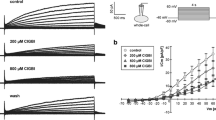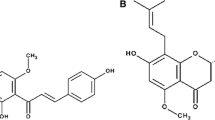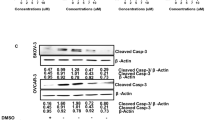Abstract
Non-steroidal anti-inflammatory drugs (NSAIDs) are known to induce apoptosis in a variety of cancer cells. However, the precise mechanisms by which NSAIDs facilitate apoptosis in tumor cells are not clear. In the present study, we show that niflumic acid (NA), a member of the fenamates group of NSAIDs and Cl− and Ca2+-activated Cl− (CAC) channels blocker, induced apoptosis (by ~8 %, 24 h treatment) and potentiated (by 8–10 %) apoptotic effect of endoplasmic reticulum Ca2+ mobilizer thapsigargin (Tg) in human erythroleukemic K562 cell line. The whole-cell patch clamp and Fluo-3 flow cytometric experiments confirmed an inhibitory effect of NA (100 and 300 µM) on store-operated (SOC) channels. We also found that NA-blocked CAC channels were activated by acute application of Tg (2 µM) in K562 cells. NA blockage of CAC channels was accompanied by activation of Ca2+-activated K+ (SK4) channels. The observed effects of NA were not connected with COX-2 inhibition since 100-nM NA (IC50 for COX-2 inhibition) did not induce either apoptosis or affect the channels activity. We conclude that inhibition of SOC channels plays a major role in NA-induced apoptosis. Increased apoptotic levels in Tg-treated K562 cells in the presence of NA may be due to the blockage of CAC and stimulation of SK4 channels in addition to SOC channels inhibition.








Similar content being viewed by others
References
Ahn SC, Seol GH, Kim JA, Suh SH (2004) Characteristics and a functional implication of Ca(2+)-activated K(+) current in mouse aortic endothelial cells. Pflugers Arch 447(4):426–435
Astill DS, Rychkov G, Clarke JD, Hughes BP, Roberts ML, Bretag AH (1996) Characteristics of skeletal muscle chloride channel C1C-1 and point mutant R304E expressed in Sf-9 insect cells. Biochim Biophys Acta 1280(2):178–186
Barry PH, Lynch JW (1991) Liquid junction potentials and small cell effects in patch-clamp analysis. J Membr Biol 121(2):101–117
Becchetti A (2011) Ion channels and transporters in cancer. 1. Ion channels and cell proliferation in cancer. Am J Physiol Cell Physiol 301(2):C255–C265
Cao Y, Prescott SM (2002) Many actions of cyclooxygenase-2 in cellular dynamics and in cancer. J Cell Physiol 190(3):279–286
Cerella C, Sobolewski C, Chateauvieux S, Henry E, Schnekenburger M, Ghelfi J, Dicato M, Diederich M (2011) COX-2 inhibitors block chemotherapeutic agent-induced apoptosis prior to commitment in hematopoietic cancer cells. Biochem Pharmacol 82(10):1277–1290
Chao TS, Abe M, Hershenson MB, Gomes I, Rosner MR (1997) Src tyrosine kinase mediates stimulation of Raf-1 and mitogen-activated protein kinase by the tumor promoter thapsigargin. Cancer Res 57(15):3168–3173
Chen Y, An H, Li T, Liu Y, Gao C, Guo P, Zhang H, Zhan Y (2011) Direct or indirect regulation of calcium-activated chloride channel by calcium. J Membr Biol 240(3):121–129
Chen GL, Zeng B, Eastmond S, Elsenussi SE, Boa AN, Xu SZ (2012) Pharmacological comparison of novel synthetic fenamate analogues with econazole and 2-APB on the inhibition of TRPM2 channels. Br J Pharmacol 167(6):1232–1243
Dam VS, Boedtkjer DM, Nyvad J, Aalkjaer C, Matchkov V (2013) TMEM16A knockdown abrogates two different Ca(2+)-activated Cl(−) currents and contractility of smooth muscle in rat mesenteric small arteries. Pflugers Arch (in print)
Davis AJ, Shi J, Pritchard HA, Chadha PS, Leblanc N, Vasilikostas G, Yao Z, Verkman AS, Albert AP, Greenwood IA (2013) Potent vasorelaxant activity of the TMEM16A inhibitor T16A(inh)-A01. Br J Pharmacol 168(3):773–784
De La Fuente R, Namkung W, Mills A, Verkman AS (2008) Small-molecule screen identifies inhibitors of a human intestinal calcium-activated chloride channel. Mol Pharmacol 73(3):758–768
Denmeade SR, Isaacs JT (2005) The SERCA pump as a therapeutic target: making a “smart bomb” for prostate cancer. Cancer Biol Ther 4(1):14–22
Feng XQ, You Y, Xiao J, Zou P (2006) Thapsigargin-induced apoptosis of K562 cells and its mechanism. Zhongguo Shi Yan Xue Ye Xue Za Zhi 14(1):25–30
Föller M, Kasinathan RS, Duranton C, Wieder T, Huber SM, Lang F (2006) PGE2-induced apoptotic cell death in K562 human leukaemia cells. Cell Physiol Biochem 17(5–6):201–210
Garg P, Sanguinetti MC (2012) Structure-activity relationship of fenamates as Slo2.1 channel activators. Mol Pharmacol 82(5):795–802
Huang YP, Ye DY (2008) Formyl-peptide receptor like 1: a potent mediator of the Ca2+ release-activated Ca2+ current ICRAC. Arch Biochem Biophys 478(1):110–118
Jiang H, Zeng B, Chen GL, Bot D, Eastmond S, Elsenussi SE, Atkin SL, Boa AN, Xu SZ (2012) Effect of non-steroidal anti-inflammatory drugs and new fenamate analogues on TRPC4 and TRPC5 channels. Biochem Pharmacol 83(7):923–931
Kaneko H, Möhrlen F, Frings S (2006) Calmodulin contributes to gating control in olfactory calcium-activated chloride channels. J Gen Physiol 127(6):737–748
Kim JA, Kang YS, Lee YS (2003) Role of Ca2+-activated Cl-channels in the mechanism of apoptosis induced by cyclosporin A in a human hepatoma cell line. Biochem Biophys Res Commun 309(2):291–297
Kim BM, Maeng K, Lee KH, Hong SH (2011) Combined treatment with the Cox-2 inhibitor niflumic acid and PPARÎ3 ligand ciglitazone induces ER stress/caspase-8-mediated apoptosis in human lung cancer cells. Cancer Lett 300(2):134–144
Kovacs G, Montalbetti N, Simonin A, Danko T, Balazs B, Zsembery A, Hediger MA (2012) Inhibition of the human epithelial calcium channel TRPV6 by 2-aminoethoxydiphenylborate (2-APB). Cell Calcium 52(6):468–480
Lang PA, Kaiser S, Myssina S, Wieder T, Lang F, Huber SM (2003) Role of Ca2+-activated K+ channels in human erythrocyte apoptosis. Am J Physiol Cell Physiol 285(6):C1553–C1560
Lee J, Cha SK, Sun TJ, Huang CL (2005) PIP2 activates TRPV5 and releases its inhibition by intracellular Mg2+. J Gen Physiol 126(5):439–451
Li L, Ma KT, Zhao L, Si JQ, Zhang ZS, Zhu H, Li J (2008a) Niflumic acid hyperpolarizes smooth muscle cells via calcium-activated potassium channel in spiral modiolar artery of guinea pigs. Acta Pharmacol Sin 29(7):789–799
Li L, Ma KT, Zhao L, Si JQ (2008b) Niflumic acid hyperpolarizes the smooth muscle cells by opening BK(Ca) channels through ryanodine-sensitive Ca(2+) release in spiral modiolar artery. Sheng Li Xue Bao 60(6):743–750
Li YS, Wu P, Zhou XY, Chen JG, Cai L, Wang F, Xu LM, Zhang XL, Chen Y, Liu SJ, Huang YP, Ye DY (2008c) Formyl-peptide receptor like 1: a potent mediator of the Ca2+ release-activated Ca2+ current ICRAC. Arch Biochem Biophys 478(1):110–118
Li XZ, Ma KT, Guan BC, Li L, Zhao L, Zhang ZS, Si JQ, Jiang ZG (2013) Fenamates block gap junction coupling and potentiate BKCa channels in guinea pig arteriolar cells. Eur J Pharmacol 703(1–3):74–82
Liantonio A, Picollo A, Babini E, Carbonara G, Fracchiolla G, Loiodice F, Tortorella V, Pusch M, Camerino DC (2006) Activation and inhibition of kidney CLC-K chloride channels by fenamates. Mol Pharmacol 69(1):165–173
Liantonio A, Giannuzzi V, Picollo A, Babini E, Pusch M, Conte Camerino D (2007) Niflumic acid inhibits chloride conductance of rat skeletal muscle by directly inhibiting the CLC-1 channel and by increasing intracellular calcium. Br J Pharmacol 150(2):235–247
Liu H, Hughes JD, Rollins S, Chen B, Perkins E (2011) Calcium entry via ORAI1 regulates glioblastoma cell proliferation and apoptosis. Exp Mol Pathol 91(3):753–760
Monteilh-Zoller MK, Hermosura MC, Nadler MJ, Scharenberg AM, Penner R, Fleig A (2003) TRPM7 provides an ion channel mechanism for cellular entry of trace metal ions. J Gen Physiol 121(1):49–60
Pifferi S, Pascarella G, Boccaccio A, Mazzatenta A, Gustincich S, Menini A, Zucchelli S (2006) Bestrophin-2 is a candidate calcium-activated chloride channel involved in olfactory transduction. Proc Natl Acad Sci USA 103(34):12929–12934
Poronnik P, Ward MC, Cook DI (1992) Intracellular Ca2+ release by flufenamic acid and other blockers of the non-selective cation channel. FEBS Lett 296(3):245–248
Prevarskaya N, Skryma R, Shuba Y (2011) Calcium in tumour metastasis: new roles for known actors. Nat Rev Cancer 11(8):609–618
Runnels LW, Yue L, Clapham DE (2001) TRP-PLIK, a bifunctional protein with kinase and ion channel activities. Science 291(5506):1043–1047
Semenova SB, Vassilieva IO, Fomina AF, Runov AL, Negulyaev YA (2009) Endogenous expression of TRPV5 and TRPV6 calcium channels in human leukemia K562 cells. Am J Physiol Cell Physiol 296(5):C1098–C1104
Subhashini J, Mahipal SV, Reddanna P (2005) Anti-proliferative and apoptotic effects of celecoxib on human chronic myeloid leukemia in vitro. Cancer Lett 224(1):31–43
Sun Y, Selvaraj S, Varma A, Derry S, Sahmoun AE, Singh BB (2013) Increase in serum Ca2+/Mg2+ ratio promotes proliferation of prostate cancer cells by activating TRPM7 channels. J Biol Chem 288(1):255–263
Tomisato W, Tanaka K, Katsu T, Kakuta H, Sasaki K, Tsutsumi S, Hoshino T, Aburaya M, Li D, Tsuchiya T, Suzuki K, Yokomizo K, Mizushima T (2004) Membrane permeabilization by non-steroidal anti-inflammatory drugs. Biochem Biophys Res Commun 323(3):1032–1039
Totzke G, Schulze-Osthoff K, Jänicke RU (2003) Cyclooxygenase-2 (COX-2) inhibitors sensitize tumor cells specifically to death receptor-induced apoptosis independently of COX-2 inhibition. Oncogene 22(39):8021–8030
Wangemann P, Wittner M, Di Stefano A, Englert HC, Lang HJ, Schlattder E, Greger R (1986) Cl(−)-channel blockers in the thick ascending limb of the loop of Henle. Structure activity relationship. Pflugers Arch 407(Suppl 2):S128–S141
Zhang GS, Liu DS, Dai CW, Li RJ (2006) Antitumor effects of celecoxib on K562 leukemia cells are mediated by cell-cycle arrest, caspase-3 activation, and downregulation of Cox-2 expression and are synergistic with hydroxyurea or imatinib. Am J Hematol 81(4):242–255
Acknowledgments
The experiments were carried out in Physiological Department I University of Tuebingen, Germany. Y. V. K. thanks the Head of Physiological Department I Prof. Dr. Florian Lang for the post-doctoral fellowship. Y. V. K. thanks Mr. David Andrew Erickson (Phoenix, USA) for correcting the final version of the manuscript.
Author information
Authors and Affiliations
Corresponding author
Rights and permissions
About this article
Cite this article
Kucherenko, Y.V., Lang, F. Niflumic Acid Affects Store-Operated Ca2+-Permeable (SOC) and Ca2+-Dependent K+ and Cl− Ion Channels and Induces Apoptosis in K562 Cells. J Membrane Biol 247, 627–638 (2014). https://doi.org/10.1007/s00232-014-9680-x
Received:
Accepted:
Published:
Issue Date:
DOI: https://doi.org/10.1007/s00232-014-9680-x




